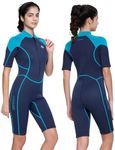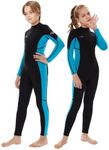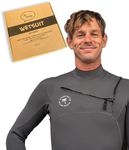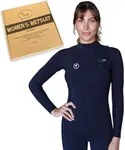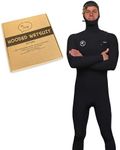Buying Guide for the Best Wetsuit For Women
Choosing the right wetsuit is crucial for comfort, performance, and safety in water activities. Whether you're surfing, diving, or swimming, a wetsuit helps to keep you warm, protect your skin, and enhance your buoyancy. To find the best wetsuit for you, consider the following key specifications and how they align with your needs.ThicknessThickness refers to the neoprene material's thickness, usually measured in millimeters. This spec is important because it determines the warmth and flexibility of the wetsuit. Thicker wetsuits (5mm or more) are ideal for colder waters, providing more insulation but less flexibility. Medium thickness (3-4mm) suits are versatile for moderate temperatures, balancing warmth and mobility. Thinner wetsuits (1-2mm) are best for warm waters, offering maximum flexibility and comfort. Choose the thickness based on the water temperature you'll be in and your tolerance to cold.
MaterialWetsuits are typically made from neoprene, a synthetic rubber that provides insulation and flexibility. The quality of neoprene can vary, with higher-end wetsuits using more advanced materials like superstretch neoprene for better comfort and movement. Some wetsuits also incorporate additional linings for extra warmth or quick-drying properties. If you prioritize flexibility and comfort, look for wetsuits with high-quality neoprene and stretch panels. For added warmth, consider suits with thermal linings.
SeamsSeams are the stitching that holds the wetsuit together, and their construction affects both durability and water resistance. Flatlock seams are durable and comfortable but allow some water to seep in, making them suitable for warmer conditions. Sealed seams (glued and blind-stitched) are more watertight, providing better insulation for colder waters. Taped seams offer the highest level of water resistance and durability. Choose the seam type based on the water temperature and your need for insulation.
FitA proper fit is essential for a wetsuit to function effectively. It should be snug but not restrictive, allowing for a full range of motion without letting water in. Women's wetsuits are designed to accommodate different body shapes, so pay attention to size charts and try on different brands to find the best fit. Consider your body measurements and look for wetsuits with features like adjustable neck closures or contoured panels for a better fit. A well-fitting wetsuit will keep you warmer and more comfortable in the water.
Entry SystemThe entry system refers to how you get in and out of the wetsuit. Common types include back-zip, chest-zip, and zipperless designs. Back-zip wetsuits are easier to put on and take off but may allow more water to enter. Chest-zip wetsuits offer better water resistance and flexibility but can be trickier to don. Zipperless wetsuits provide the best seal and flexibility but require more effort to wear. Choose an entry system based on your preference for ease of use versus water resistance and flexibility.
StyleWetsuits come in various styles, including full suits, spring suits, and shorties. Full suits cover the entire body and are ideal for colder conditions, providing maximum insulation. Spring suits have short sleeves and legs, suitable for warmer waters where you need some protection but not full coverage. Shorties are similar to spring suits but even shorter, offering minimal coverage for the warmest conditions. Select the style based on the water temperature and the level of coverage you need for your activity.




